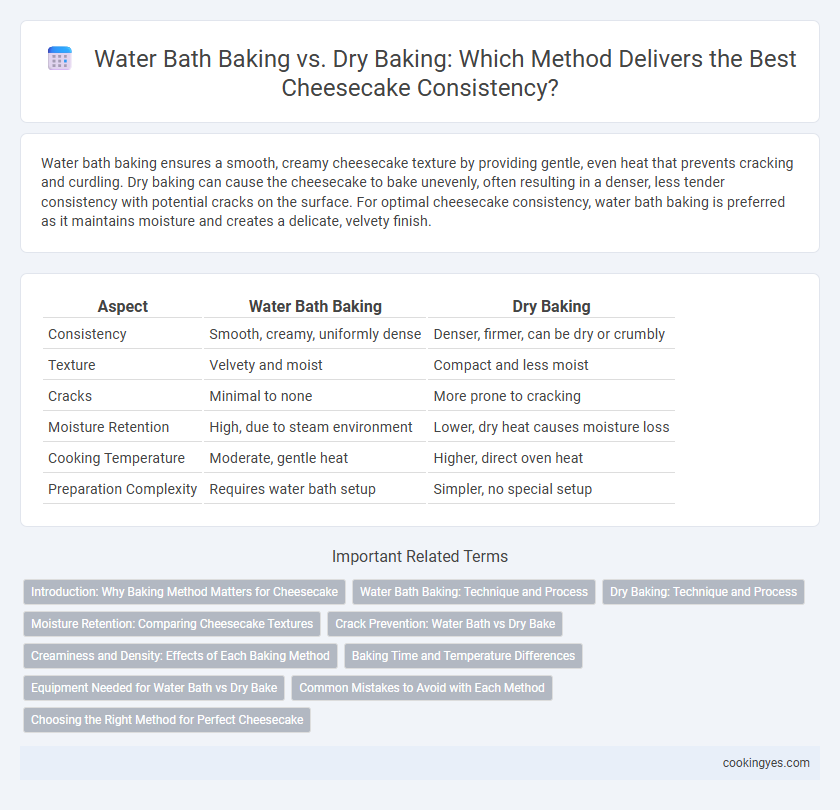Water bath baking ensures a smooth, creamy cheesecake texture by providing gentle, even heat that prevents cracking and curdling. Dry baking can cause the cheesecake to bake unevenly, often resulting in a denser, less tender consistency with potential cracks on the surface. For optimal cheesecake consistency, water bath baking is preferred as it maintains moisture and creates a delicate, velvety finish.
Table of Comparison
| Aspect | Water Bath Baking | Dry Baking |
|---|---|---|
| Consistency | Smooth, creamy, uniformly dense | Denser, firmer, can be dry or crumbly |
| Texture | Velvety and moist | Compact and less moist |
| Cracks | Minimal to none | More prone to cracking |
| Moisture Retention | High, due to steam environment | Lower, dry heat causes moisture loss |
| Cooking Temperature | Moderate, gentle heat | Higher, direct oven heat |
| Preparation Complexity | Requires water bath setup | Simpler, no special setup |
Introduction: Why Baking Method Matters for Cheesecake
Water bath baking maintains consistent moisture and gentle heat, preventing cracks and ensuring a smooth, creamy cheesecake texture. Dry baking often exposes the cheesecake to uneven heat, which can cause overcooked edges and a denser, crumbly consistency. Choosing the right baking method directly impacts the cheesecake's final texture and visual appeal, making water bath baking preferable for achieving a custard-like softness.
Water Bath Baking: Technique and Process
Water bath baking for cheesecake involves placing the cheesecake pan inside a larger pan filled with hot water, ensuring gentle and even heat distribution that prevents cracking and promotes a creamy texture. This technique maintains consistent moisture and temperature, allowing the cheesecake to cook slowly and evenly, which enhances its smooth, dense consistency. Ensuring the cheesecake pan is wrapped in foil before immersing it in the water bath prevents leaks and preserves the delicate baking environment crucial for optimal results.
Dry Baking: Technique and Process
Dry baking cheesecake involves cooking the batter in a preheated oven without added steam or water, resulting in a denser and firmer texture compared to water bath baking. This technique requires precise temperature control, typically around 325degF, and a longer baking time to prevent cracking and overbaking. The absence of moisture in the oven allows the cheesecake to develop a slightly golden top and a rich, custard-like consistency favored in traditional New York-style cheesecakes.
Moisture Retention: Comparing Cheesecake Textures
Water bath baking preserves moisture by gently heating cheesecake, resulting in a creamy, smooth texture with minimal cracks. Dry baking exposes the cake to direct heat, causing faster evaporation and a denser, firmer texture with a crumbly surface. The moisture retention in water bath methods yields a delicate, velvety consistency preferred for classic cheesecakes.
Crack Prevention: Water Bath vs Dry Bake
Water bath baking ensures gentle, even heat that prevents cracks by maintaining consistent moisture around the cheesecake, reducing sudden temperature changes that cause surface splitting. Dry baking exposes the cheesecake to direct oven heat, increasing the risk of cracks due to uneven baking and drying out the edges. For a smooth, crack-free cheesecake, water bath baking offers superior consistency by controlling temperature and moisture levels throughout the process.
Creaminess and Density: Effects of Each Baking Method
Water bath baking for cheesecake creates a gentle, evenly distributed heat that prevents cracking and promotes a creamy, smooth texture by maintaining moisture throughout the baking process. In contrast, dry baking results in a denser and firmer cheesecake texture due to sharper temperature fluctuations and faster evaporation of moisture. Cheesecake consistency achieves maximum creaminess and softness with water bath baking, while dry baking produces a more compact, dense structure suitable for firmer dessert preferences.
Baking Time and Temperature Differences
Water bath baking maintains a consistent temperature around 325degF, ensuring gentle, even heat that prevents cracking and produces a creamy, smooth cheesecake texture. Dry baking typically requires a slightly higher temperature, around 350degF, with shorter baking times but risks a denser texture and uneven cooking. Water bath methods extend baking time by 10 to 20 minutes compared to dry baking, promoting moisture retention and a velvety consistency.
Equipment Needed for Water Bath vs Dry Bake
Water bath baking requires a large roasting pan to hold hot water and a smaller springform pan for the cheesecake to ensure gentle, even cooking that prevents cracking. Dry baking only needs a springform pan and can benefit from using a baking sheet underneath to catch drips and simplify cleanup. A water bath setup demands extra care in wrapping the springform pan with foil to avoid water seeping in, while dry baking relies more on precise oven temperature control to maintain creamy consistency.
Common Mistakes to Avoid with Each Method
Water bath baking helps prevent cracks by maintaining a moist oven environment, but common mistakes include using a loose foil wrap that allows steam to seep in or not preheating the water, which affects consistency. Dry baking often leads to a denser texture and cracked surfaces if the oven temperature is too high or the cheesecake is overbaked, causing uneven cooking. Avoiding these pitfalls ensures a smooth, creamy cheesecake with optimal texture regardless of the baking method.
Choosing the Right Method for Perfect Cheesecake
Water bath baking prevents cracks by maintaining gentle, even heat and moisture, resulting in a smooth, creamy cheesecake texture. Dry baking yields a denser, firmer cheesecake with a slightly drier surface but can develop cracks without careful temperature control. Selecting the appropriate method depends on the desired cheesecake consistency: water bath for silky smoothness and dry baking for a more robust, rich texture.
Water Bath Baking vs Dry Baking for Cheesecake Consistency Infographic

 cookingyes.com
cookingyes.com